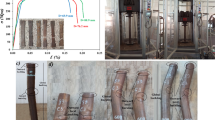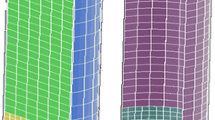Abstract
For accurate analysis of steel composite circular columns, nonlinear material properties considering lateral confinement are required. Therefore, the material properties were modified after the experimental results from this study were compared with the results available in the literature. A nonlinear numerical analysis application, which can reflect and analyze the load-displacement, moment-curvature and P-M interaction, was developed on the basis of the modified stress-strain relation. The experimental results were compared with analysis results by using this application for concrete-filled tube (CFT) and concrete-encased tube (CET) circular columns. Results from the comparison show that the current code specifications are conservative because some of them do not consider the strength enhancement by the confined effect. This finding indicates the necessity to reflect nonlinear material properties considering the confined effect in the analysis of the composite columns.
Similar content being viewed by others
References
ACI Committee 318 (2002). Building code requirements for structural concrete (318-02) and Commentary (318R-02). American Concrete Institute, Detroit.
AISC (2011). Steel construction manual, 14rd Edition. American Institute of Steel Construction.
Hu, T., Huang, C. S., and Chen, Z. L. (2005). “Finite element analysis of CFT columns subjected to an axial compressive force and bending moment in combination.” Constructional Steel Research, 62, pp. 1692–1712.
Ichinohe, Y., Matsutanj, M., Nakajima, H., Ueda, H., and Takada, K. (1991). “Elasto-plastic flexural behavior of concrete-filled steel tubular columns.” Proc. 3 th ASCCS Int. Cont. on Steel-Concrete Composite Structures, pp. 131–136 (in Japanese).
Kent, D. C. and Park, R. (1971). “Flexural members with confined concrete.” Journal of Structural Division, 97(ST7), pp. 1969–1989.
KBC (2009). Korean Building Code. Korean Ministry of Construction and Transportation (in Korean).
Mander, J. B., Priestly, M. J. N., and Park, R. (1988). “Theoretical stress-strain model for confined concrete.” Journal of Structural Engineering, 114(8), pp. 1804–1826.
Matsumoto, M., Sakino, K., and Ninakawa, T. (1995). “The proposed stress-strain relationships model for the flexural behavior of CFT columns.” Report of Kyushu Branch, AIJ, 35(1), pp. 529–532 (in Japanese).
Richart, F. E., Brandtzaeg, A., and Brown, R. L. (1928). A study of the failure of concrete under combined compressive stresses. Bulletin No. 185, University of Illinois Engineering Experimental Station, Urbana, Ill.
Saatcioglu, M. and Razvi, S. R. (1992). “Strength and ductility of confined concrete.” Journal of Structural Engineering, 118(6), pp. 1590–1607.
Author information
Authors and Affiliations
Corresponding author
Additional information
Note.-Discussion open until November 1, 2012.
Rights and permissions
About this article
Cite this article
Park, KD., Kim, HJ. & Hwang, WS. Experimental and numerical studies on the confined effect of steel composite circular columns subjected to axial load. Int J Steel Struct 12, 253–265 (2012). https://doi.org/10.1007/s13296-012-2009-7
Received:
Accepted:
Published:
Issue Date:
DOI: https://doi.org/10.1007/s13296-012-2009-7




